Table A. Year-on-Year Inflation Rates: All Items in Percent
Philippines, Region 11 and Davao del Norte
January 2022, December 2022 – January 2023 
Source: Retail Price Survey of Commodities for the Generation of Consumer Price Index Philippine Statistics Authority
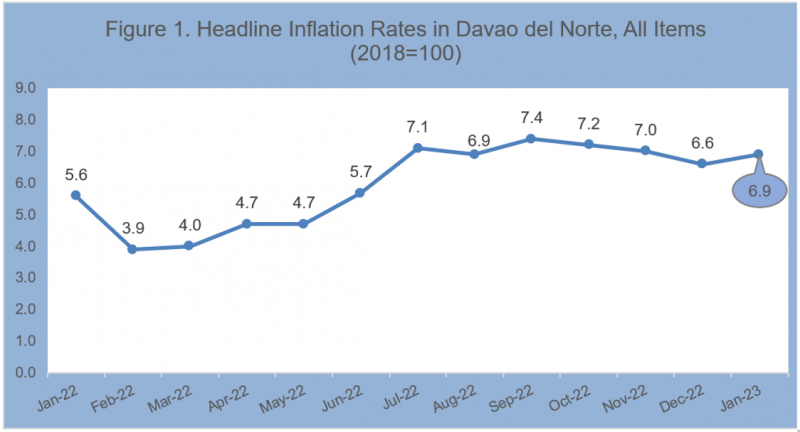
Source: Retail Price Survey of Commodities for the Generation of Consumer Price Index Philippine Statistics Authority
- Inflation in Davao del Norte
The headline inflation in Davao del Norte increased by 1.3 percentage points in January 2023 (6.9%) compared to its inflation rate in the same month last year, which was recorded at 5.6 percent. The current inflation rate (6.9%) of the province is lower compared to the headline inflation of the Philippines and Davao Region, which stood at 8.7 percent and 9.4 percent, respectively (Table A).
Table B. Year-on-Year Inflation Rates in Davao del Norte:
All Items in Percent
January 2020 – January 2023
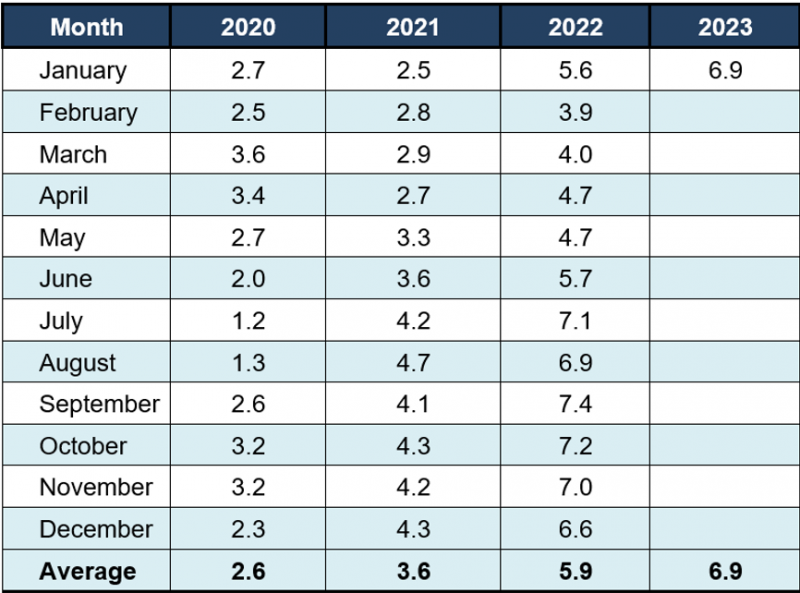
Source: Retail Price Survey of Commodities for the Generation of Consumer Price Index Philippine Statistics Authority
- Contribution to the Inflation
Table C showed that the January 2023 inflation of Davao del Norte is mostly contributed by the indices of food and non-alcoholic beverages (7.8%); housing, water, electricity, gas and other fuels (7.8%); and transport (8.9%).
Table C. Major Contributor to the Inflation in Davao del Norte: All income Households in Percent (2018=100)
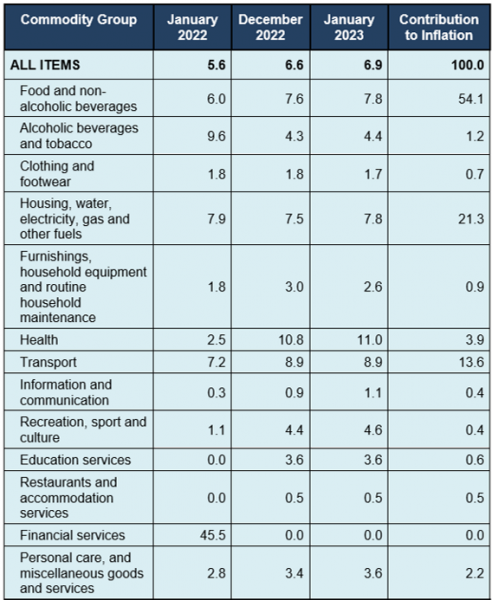
Source: Retail Price Survey of Commodities for the Generation of Consumer Price Index Philippine Statistics Authority
- Share to the Trend of Inflation
Table D. Share to the Uptrend of Inflation in Davao del Norte: All income Households in Percent (2018=100)
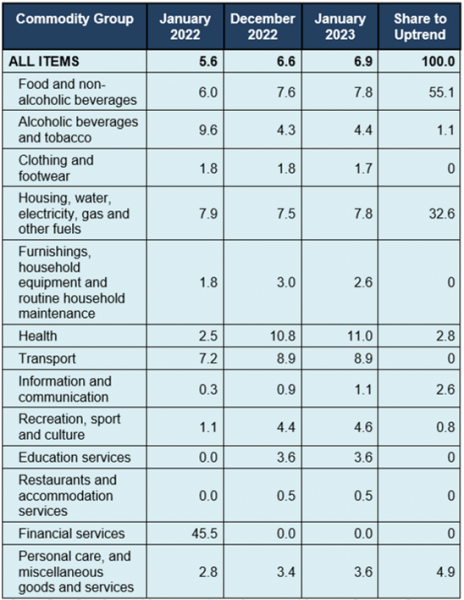
Source: Retail Price Survey of Commodities for the Generation of Consumer Price Index Philippine Statistics Authority
The increment in the inflation rate of Davao del Norte can be observed with its upward trend from 6.6 percent in December 2022 to 6.9 percent in January 2023. This increase is mainly contributed by the indices for food and non-alcoholic beverages, from a rate of 7.6 percent in December 2022 to 7.8 percent in January 2023. This is followed by the indices of housing, water, electricity, gas and other fuels (from 7.5% to 7.8%), and personal care, and miscellaneous goods and services (from 3.4% to 3.6%). (Table D).
Despite the increase of inflation rate in the province, a downward trend in January 2023 compared to their corresponding rates in December 2022 were observed in Table D for the following commodities:
- Clothing and footwear (from 1.8 to 1.7)
- Furnishings, household equipment and routine household maintenance (from 3.0 to 2.6)
It can also be observed that the commodities for transport; education services; restaurants and accommodation services; and financial services has shown no sign of increase nor decrease in inflation rate in comparison to their corresponding rates in the last month.
While the index for food stayed the same at 7.8 percent from December 2022 to January 2023. Despite this consistent rate, notable increase in the inflation rate of the following food commodities can be observed in January 2023:
- Fish and other seafood (from -3.5 to 5.1)
- Cereals and cereal products (from 5.1 to 6.6)
- Fruits and nuts (from 3.0 to 8.6); and
- Ready-made food and other food products n.e.c. (from 8.6 to 9.0)
Table E. Share to the Downtrend of Food Inflation in Davao del Norte: All income Households in Percent (2018=100)
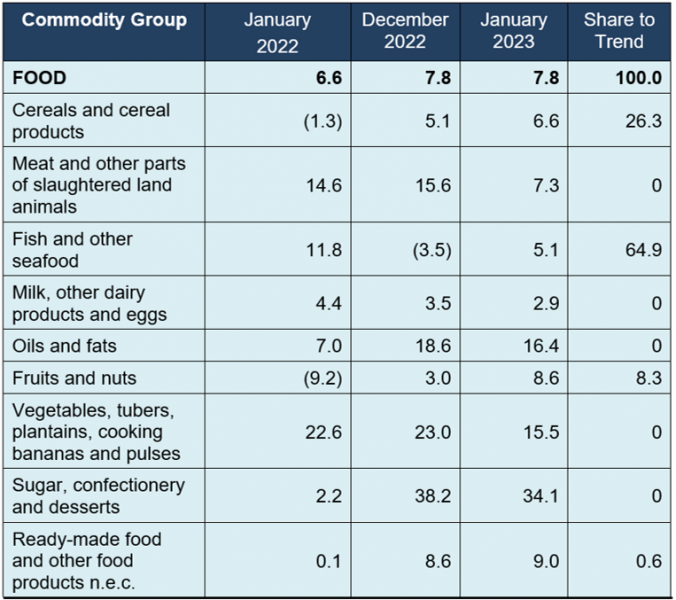
Source: Retail Price Survey of Commodities for the Generation of Consumer Price Index Philippine Statistics Authority
- Purchasing Power of Peso
The Purchasing Power of Peso (PPP) measures the current value of the peso in reference to its value in the base year. It has an inverse relationship with the Cosumer Price Index (CPI), which means that if the CPI increases, the PPP decreases.
Figure 2 showed that the PPP for the province of Davao del Norte decreased and was recorded at 0.84 in January 2023. This suggests that Php100.00 in 2018 is currently valued at PhP84.00.
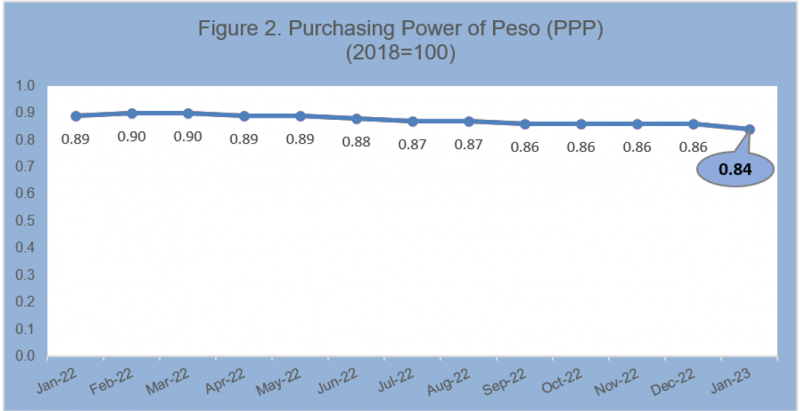
Source: Retail Price Survey of Commodities for the Generation of Consumer Price Index Philippine Statistics Authority
Technical Notes
Consumer Price Index (CPI). An indicator of the change in the average retail prices of a fixed basket of goods and services commonly purchased by households relative to a base year.
Based Period. A reference date at which the index is equal to 100. The Base year is 2018.
Inflation Rate. The rate of change of the CPI expressed in percent. It is interpreted in terms of declining purchasing power of peso.
Purchasing Power of Peso. The measure of how much the peso in the base period is worth in the current period.
Note: Consumer Price Indices (CPI) and inflation rates by province and selected cities are posted at the PSA website (https://openstat.psa.gov.ph/).
Approved for Release:
PEPITO D. AMOYEN
Chief Statistical Specialist
